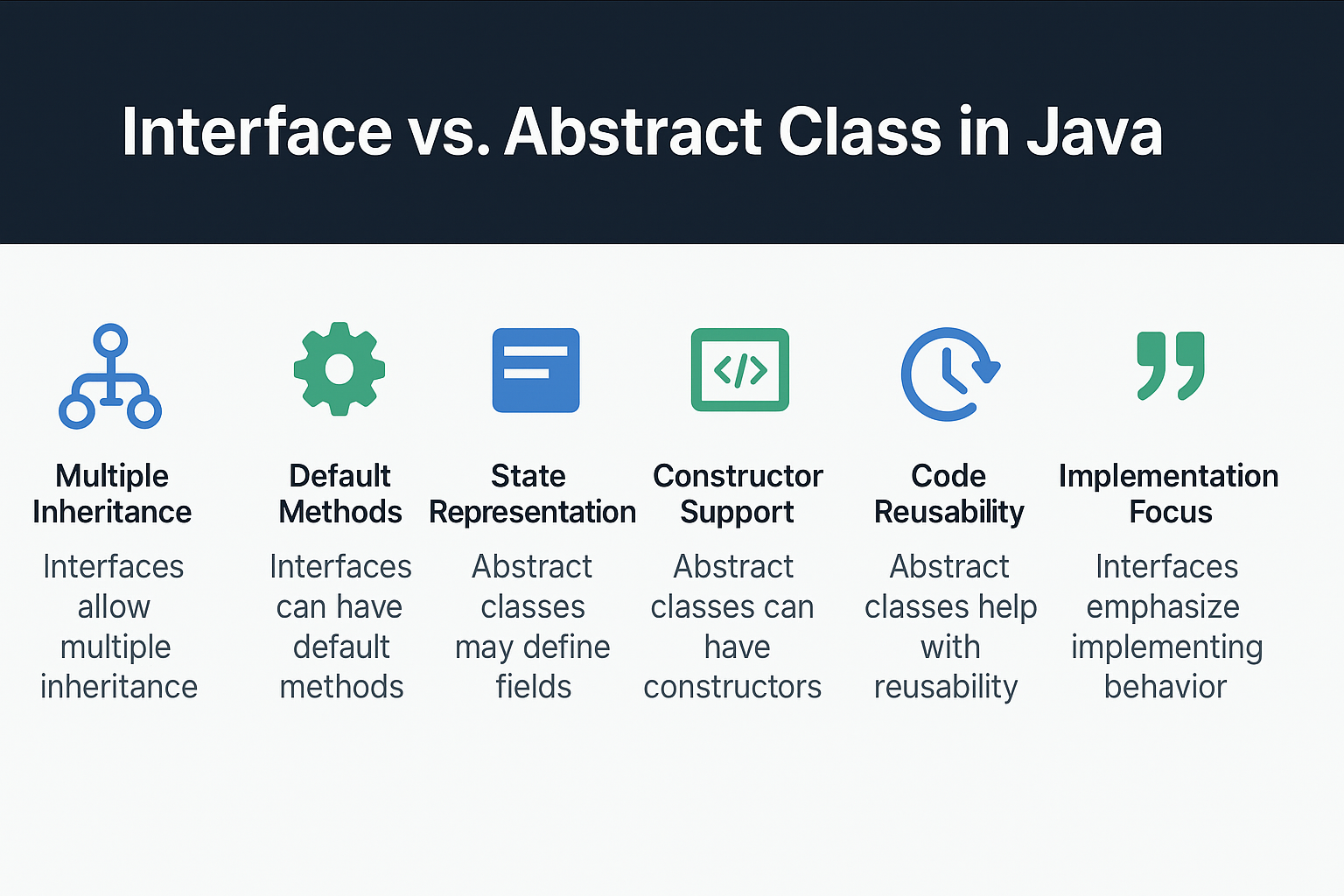Introduction
Object-Oriented Programming (OOP) emphasizes abstraction, inheritance, encapsulation, and polymorphism. Among these, abstraction allows you to hide implementation details and expose only the essential features of an object.
Java supports abstraction through abstract classes and interfaces. This guide dives deep into abstract classes—when and why you should use them, their role in enterprise applications, and how they differ from interfaces.
What is an Abstract Class?
An abstract class in Java is a class that cannot be instantiated and may contain abstract methods (methods without a body) as well as concrete methods (methods with implementation).
Syntax:
abstract class Vehicle {
abstract void start();
void fuel() {
System.out.println("Fuels the vehicle.");
}
}
Key Characteristics:
- Declared using the
abstractkeyword. - Can contain both abstract and concrete methods.
- Can define constructors and member variables.
- Subclasses must implement all abstract methods unless they are also declared abstract.
Why Use Abstract Classes?
1. Enforcing a Template
Abstract classes provide a partial implementation of functionality and enforce subclasses to implement specific behaviors.
abstract class Animal {
abstract void sound();
void eat() {
System.out.println("Animal is eating.");
}
}
2. Code Reuse with Shared Logic
You can provide shared logic (non-abstract methods) in an abstract class for all subclasses to use.
abstract class Account {
void calculateInterest() {
System.out.println("Default interest calculation.");
}
}
3. Controlled Extension
Abstract classes allow controlled behavior through inheritance, making them ideal for defining contracts and sharing reusable logic.
Java Code Example
abstract class Shape {
abstract double area();
void printShape() {
System.out.println("This is a shape.");
}
}
class Circle extends Shape {
double radius;
Circle(double radius) { this.radius = radius; }
double area() { return Math.PI * radius * radius; }
}
public class Main {
public static void main(String[] args) {
Shape s = new Circle(5);
s.printShape();
System.out.println("Area: " + s.area());
}
}
UML-style Structure
+-------------------+
| Shape | <<abstract>>
+-------------------+
| - radius: double |
+-------------------+
| +area(): double |
| +printShape(): void |
+-------------------+
▲
|
+------------+
| Circle |
+------------+
Abstract Class vs Interface
| Feature | Abstract Class | Interface (Java 8+) |
|---|---|---|
| Inheritance | Single | Multiple |
| Method Types | Abstract + Concrete | Abstract + Default + Static |
| Constructor | Yes | No |
| Use Case | Partial implementation | Full abstraction or contracts |
Common Misuse Cases
- Using abstract class when no shared code is needed → Prefer interface.
- Forgetting to implement all abstract methods → Compilation error.
- Overusing inheritance instead of composition.
Java Version Notes
From Java 8 onwards, interfaces can also have default and static methods, reducing the gap with abstract classes. However, abstract classes still support constructors, instance variables, and non-static blocks, which interfaces don't.
In Java 17+, the sealed keyword can be used with abstract classes to restrict which classes may extend them:
public sealed abstract class Animal permits Dog, Cat {}
Real-World Analogy
Think of an abstract class as a blueprint. For example, Vehicle is an abstract idea. You can't create a "vehicle" directly, but you can create specific types like Car, Truck, or Bike that implement the blueprint.
Best Practices
- Use abstract classes when behavior is shared across a family of classes.
- Prefer composition over inheritance if the relationship is not truly IS-A.
- Don’t mix unrelated concerns in a single abstract class.
Conclusion
Abstract classes are a powerful way to provide structure and partial implementation in Java. They strike a balance between complete abstraction (interface) and complete implementation (concrete classes), making them ideal in layered application architectures.
Key Takeaways
- Abstract classes define a partial blueprint for subclasses.
- Use when subclasses share behavior and data.
- Java interfaces are better when full abstraction or multiple inheritance is needed.
- With Java 8+, interfaces can have default methods but still lack constructors and state.
FAQs
1. Can an abstract class have a constructor?
Yes, but it can only be used during subclass instantiation.
2. Can we instantiate an abstract class?
No. Abstract classes cannot be instantiated directly.
3. Can abstract class have static methods?
Yes, static methods are allowed and belong to the class.
4. What happens if a subclass does not implement all abstract methods?
It must be declared abstract or implement all missing methods.
5. Can abstract classes implement interfaces?
Yes, and they can choose to implement all or some methods.
6. Is it mandatory to have at least one abstract method in an abstract class?
No. A class can be abstract without any abstract method.
7. Can abstract methods be private?
No. Abstract methods must be at least protected or public.
8. What’s the difference between abstract class and interface in Java 8+?
Interfaces can have default/static methods but lack constructors and instance variables.
9. Can an abstract class extend another abstract class?
Yes. It can also inherit or add new abstract methods.
10. When should I use abstract class over interface?
When you need to share code across related classes or manage state.
